Leptospermum laevigatum



Furrowed
Having thick bark forming furrows .
Vase-shape
When a plant has upright spreading branches with an outline shape of a vase.This large shrub to small tree has single or multiple furrowed trunks and spreading branches that form an irregular open crown. It has small grey-green oblong leaves and the white wheel-shaped flowers appear in early spring.
Leptospermum laevigatum (Gaertn.) F. Muell. is naturally found from south-eastern Queensland to eastern New South Wales, extending to coastal Victoria and South Australia where it is regarded as an environmental weed. It is also found in northern Tasmania and has naturalised in Western Australia where it grows in open sandy coastal or inland regions and is invasive. It commonly appears along the beaches in dunes or in the adjoining hillsides amongst dry sclerophyll forests from sea level to an altitude of 760m (2,493 ft) or more. It is also cultivated in New Zealand, south-western USA and southern Africa where it is regarded as a weed. This adaptable small tree grows in well drained, moist to dry moderately fertile sandy to light clay loam that is slightly acidic to neutral with a pH range from 6.0 to 7.0. It prefers an open to exposed sunny position and tolerates salt spray, drought and frost with a minimum temperature of -6ºC (21ºF).
The Coastal Tea Tree is grown for its bushy spreading-weeping habit and its small white flowers. This variable shrub to small tree is planted in coastal gardens as a wind break where it becomes wind pruned or stunted. In protected positions it forms a small tree with a rounded weeping crown and can be used for screening. It is also used in revegetation programs and can be trimmed to form a informal hedge along borders. It is bird attractive and has a vigorous growth rate establishing in 2 to 3 years but care should be taken as the plant self-seeds and becomes weedy under ideal conditions. When young it can be cultivated in tubs or planter boxes and can be trained as a bonsai subject. It has a low water requirement once established (Scale: 1-drop from 3), responding to mulch and an can tolerate prolong periods of drought.
I.D. 169
UK hardiness zone H1c
Climate zones 14 - 24, H1, H2
USDA Zone 9-11
Leptospermum (lep-to-SPERM-um) laevigatum (lee-vih-GAY-tum)
Etymology
Genus: Greek - Leptospermum – from ‘leptos’ meaning (fine or slender) and ‘sperma’ meaning (a seed) referring to the small seeds produced
Species: Latin - laevigatum – meaning (smooth), referring to the texture of the leaves.

Australia (Queensland, New South Wales, Victoria, South Australia, Tasmania)
Myrtaceae (mir-TAY-see-ee)
Myrtle, Eucalyptus, Clove and Guava Family
This is a large family of shrubs, mallee and trees with showy stamens and peeling bark. It has a large representation in the Australian landscape.
Distribution
The plants in this family are predominantly found in the southern Hemisphere with 75 genera native to Australia and the remaining distributed in South America, Africa and the neighbouring islands. They are located in tropical rainforests, sclerophyll, heaths and woodlands in rich to poor dry soils.
Diagnostic Features
The simple leaves are normally opposite; occasionally spirally arranged with no stipules and normally an entire margin. There are pellucid oil glands dotted on the leaf, which may be obscured and when the leaf is crushed it is aromatic.
The juvenile, intermediate and adult leaves may be different in arrangement and shape on the same plant.
The regular flowers are hermaphrodite or sometimes unisexual and may be axillary, solitary, or arranged in cymes, umbles, terminal spikes, racemes or panicles. The floral tube covers the ovary and may continue above the ovary summit and form a disk around the ovary.
There are 4 to 5 sepals and petals normally fused to form a calyptra or are free.
The stamens are five to many and may be free or fused into 5 bundles that are opposite the petals.
They have an inferior to semi-inferior ovary that has 1 to 10 carpels, normally five with 1 to many ovules that are inserted on an axil that is basal or rarely a parietal placenta.
The style ends with a narrow stigma and the anthers normally open with longitudinal slits or pores.
The fruit may be a capsule, berry, nut or drupe-like with the cup that surrounds the ovary that is fleshy or dry and woody.
The seed may vary in structure and the cotyledons may be small or large.
Note:
This family has many attractive species and are extensively used in ornamental. Eucalyptus, Melaleuca, Callistemon and Thryptomrnes are just some of the plants represented and they are normally pollinated by insects, birds and in some cases by mammals.
Plant use: border planting, bee attractive, bird attractive, bushland settings, commercial sites, coastal or inland regions, creek or river embankments, dense screening, feature specimen, foliage contrast, parks and large gardens, sub-tropical, warm temperate, Mediterranean, suitable for California, eastern Australia, woodland settings
This plant tolerates between USDA zones 9a to 11a and grows to 6 m (20 ft)
Fahrenheit 20º to 45º F
These temperatures represent the lowest average
Celsius -3.9º to 7.2º C
Attention
This plant was last revised on the 11/09/2023
All photographs and data are covered by copyright. Apart from any fair dealing for the purpose of private study, research, reference or review, as permitted under the Copyright Act, no part including images and text may be reproduced by any means without written permission. The information presented in the map is only indicative and may contain errors and omissions. All inquiries should be addressed to sales@plantfile.com attention Peter Kirkland.

Simple
The leaf that is not divided.
Obovate
A leaf that is broadest at the apex tapering towards the base.
Alternate
Leaves are arranged alternately along the stem.
Entire
A leaf margin with no irregularities (smooth).
Rotate
The petals form a wheel shape.
Solitary
When a flower that arises singly from within the axis of a leaf or terminally.| Jan | Feb | Mar | Apr | May | Jun |
| Jul | Aug | Sep | Oct | Nov | Dec |
The 20 mm (¾ in) wide rotate flower has 5-free obovate white petals with undulating margins and appear solitary or in pairs, profusely in the upper leaf axils during early spring.

Capsule
A dried dehiscent fruit, with an enclosing membrane normally containing may seeds."| Jan | Feb | Mar | Apr | May | Jun |
| Jul | Aug | Sep | Oct | Nov | Dec |
The domed woody capsule is up to 10 mm (3/8 in) wide and has 6-11compartments with slightly exserted valves that open from the top with the persistent 5-lobed calyx attached around the rim. The tiny small winged viable seeds and germinate readily but the plant can be reproduced vegetatively.
The Coastal Tea Tree is variable and is grown for its weeping habit and flowers. It is planted in coastal gardens along borders for screening or as a wind break and is used as a street tree. It establishes in 2 to 3 years and in protected positions it will form an upright tree with a rounded weeping crown. In exposed coastal positions the tree becomes wind pruned or stunted and normally forming a shrubby habit. This plant can be trained as a bonsai subject.
Note:
This plant is susceptible to Dieback Borer, Jewel Beetles, Nectar Scarabs, Fruit Tree Borer, case moth and Christmas Beetle.
General pruning information
This plant will not regenerate from a hard prune into old wood but respond from a light trim directly after flowering.
Surface sow fresh seed during spring and prick out when large enough to handle. Pot up into a well drained media.
Take semi hardwood cuttings from summer to autumn and maintain a warm humid environment.
Propagation by Seed (General)
Germination
In order for a seed to germinate it must fulfil three conditions.
1. The embryo must be alive (a viable seed).
2. The seed must have no dormancy-inducing physiological, physical or chemical barrier to germination; also the seed must be nondormant.
3. The seed must have the appropriate environmental requirements, water, temperature and oxygen.
The interaction between these requirements and dormancy is complex and may lead to different environmental requirements that avoid the dormancy of a seed.
Sowing Seeds in Containers
There are two general methods for germinating seeds.
1. Sowing seeds in a flat or germinating bed, through which seedlings are pricked-out then, transplanted into another flat with wider spacing or directly to an individual pot.
2. Sowing seeds by placing them in to flats with the appropriate spacing or into individual pots.
This method is normally carried out with medium to large seeds such as woody plants and plants that are difficult to transplant.
Seedling production normally occurs in a greenhouse / glasshouse, cold frames and on hot beds.
Method of Seed Sowing
Fine seed is sown in pots or flats that are no deeper than 70 to 80 mm. using a sterilised well-drained media (soil). Fill the container to 20 mm from the top and sprinkle sieved peat to 3 mm depth.
Press the media down level and firm with a piece of timber and then thoroughly moisten.
Mix the fine seed with washed sand and then sow thinly on the surface. These may be lightly covered with sand.
Larger seeds may be covered with media or a hole is dibbled and the seed is placed in the media.
Watering Methods
For watering you may either mist the containers from above or place the container in tepid water and allow the water to raise through the pot to the surface of the media, then drain away and do not fill to the top of the container.
Place a piece of glass over the pot and store in a protected warm environment (glasshouse).
Seeds germinate best in darkness so shade the containers if in direct sunlight.
After the seedlings have sprouted remove the glass and ease the seedlings into direct light.
When the seedlings are large enough prick them out and transplant into larger containers and place them in a shade house to harden off.
Many seeds have different methods of seed preparation for germination such as nicking or cutting the seed coat to allow water penetration, also placing seeds in hot water and allowing it to cool off.
This is particularly important as it is softening the seed coat.
Asexual Propagation (Cuttings general)
Propagation from cuttings is possible because every cell of a plant containers the genetic information to create an entire plant.
1. Reproduction occurs through the formation of adventitious roots and shoots.
2. The uniting of vegetative parts with budding and grafting.
3. Taking stem cuttings and layering is possible due to the development of adventitious roots
4. Root cuttings can form new shoots and it is possible to join roots and shoots to form a new plant.
5. A new plant may be formed from a single cell in an aseptic culture system, (cloning).
It is important to propagate vegetatively as this form of cloning retains the unique characteristics of the cultivars or where particular aspects of a plant may be lost if propagated by seed.
Equipment Required for Taking Cuttings
1. A sharp knife that is not too large or a razor mounted in a handle.
2. Good pair of sharp secateurs that is clean.
3. A dibbler to make a hole in the media and allow the cutting to be placed in.
4. Propagation structures that are either a timber frame with glass or polyethylene cover or a glasshouse.
The object of the structure is to create an environment where the temperature and humidity can be controlled. This can be achieved with a simple cover over a pot with a wire frame and plastic.
This stops the draughts and maintains humidity.
5. A hotbed is a useful item as many plants root more quickly if the media is slightly warmer.
Bottom heat is obtained from thermostatically controlled heating cables that are running under the media.
6. Misting systems are of great benefit to cuttings as the regulated fogging with water inhibits the cuttings from drying out and as a result the cuttings may be grown in full sun.
This results in faster root development and less subject to diseases by fungi and bacteria.
7. Rooting mediums
The rooting medium must be well drained, sand may be used as long as it is thoroughly washed and leached of all salts. It is very well drained and it is excellent for cutting that root up quickly. Equal parts of sand and peat moss have good results for cuttings, which are left for a period of time to allow the roots to form.
Vermiculite and perlite are also used as a well-drained rooting media but has the same disadvantage as sand having no nutrients. The cuttings must be potted up as soon as the roots developed, or a light application of liquid fertiliser can be applied.
Types of Cuttings
Stem cuttings
These are the main types of cuttings.
1. Softwood cuttings
These cuttings are taken from young growth on side shoots and tip growth.
2. Semi hardwood cuttings
These cuttings are taken from wood that is firmer and semi ripe usually during mid summer.
3. Hardwood cuttings
These cuttings are taken from mature wood normally towards the end of the season.
4. Root cuttings
Cut sections of roots to obtain new plants during late winter to early spring.
5. Leaf Ccuttings
Cut the leaf blade in order to obtain new plants during the growing period of the plant.
Cutting preparation
Hardwood cuttings
When taking hardwood cuttings remove the leaves and in semi hardwood reduce the number of leaves by half. Cut the wood straight across just below a node or joint. Hardwood cuttings are normally between 100 to 760 mm long and may have either a heel of the older wood attached to the base, or a short section of the older wood at the base. These cuttings are prepared during the dormant season from late autumn to early spring and are made up from previous season's growth.
This type of cutting is used for woody deciduous plants such as Crepe Myrtle, Rose rootstocks and some fruit trees.
The cuttings should be healthy wood with ample supply of stored food as to nourish developing roots and shoots and placed in the rooting media with the aid of a dibbler stick.
Softwood cuttings
The cuttings for softwood should be 60 to 130 mm long and be of material with enough substance as to not deteriorate before the new roots appear. Cut below a node and retain the leaves on the upper portion. Place in a well-drained media and maintain a high humidity.
Soaking the cuttings and leaving them standing in water for long periods is undesirable.
Herbaceous cuttings
These cuttings are taken from succulent plants such as Geraniums and Coleus. The cutting should be 70 to 130 mm long with leaves retained on the upper end. As in softwood cuttings these require an environment of high humidity. Some fleshy cuttings ooze sap and may require a drying period for a few hours before being placed in the rooting media.
Leaf cutting
In these cuttings a leaf blade and petiole or part off is used to raise a new plant. The original leaf doses not become a part of the new plant as roots and shoots appear from the base of the leaf. In some cases roots appear from the severed veins.
Leaf-Bud cuttings
These cuttings incorporate a leaf, petiole and a small piece of the stem. These cuttings are an advantage where the plant uses the axillary bud at the base of the petiole for new shoot growth and maximises available propagation material, as each node will produce a new plant.
As in softwood cuttings these require an environment with high humidity and warmth.
Root cuttings
These cuttings are best taken from younger plants during late winter to early spring prior the new season's growth unless the dormant period is during summer.
Trim the roots as they are dug up and to maintain polarity cut strength at the crown end and a slanted cut at the distal end (away from the crown).
Root cuttings of small plants are placed in flats in lengths of 20 to 50 mm and laying horizontally on the surface of the soil. These may be lightly covered with sieved sand or media, watered and then placing a piece of glass or polyethylene over the container till roots / shoots appear.
Fleshy root cuttings
These cuttings should be 50 to 75 mm long and placed vertically in a well-drained sand media.
Keep the polarity correct and when the roots develop transplant the cuttings into a separate container.
Large root cuttings
These cuttings are 50 to 150 mm long and are tied up in bundles and placed in boxes of damp sand, sawdust or peat for about three weeks at a temperature of 4. 5 deg C. When taken out they should be planted in a prepared bed 50 to 80 mm apart with the tops of the cuttings level with or just below the soil level.
PEST
NAME
Sawfly (General)
Various Sawfly Species
ORDER
Hymenoptera
Description of the Pest
Adult sawflies are wasps that have derived the name Sawfly from the sawing action to open leaves using there ovipositor. The adults are usually colourful insects. The fleshy larvae normally are tapering caterpillars, some with pointed spine on the tale and are many different colours from black-blue to brown and orange.
These insects have a Holometabolous life cycle, ie. When metamorphosis is observed during the pupal stage.
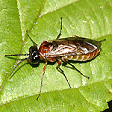

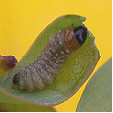
They are commonly called "spitfires" because, when disturbed, they bend back their bodies and exude a strong, eucalyptus-scented liquid from their mouths. This exudate contains concentrated eucalyptus oil, which can cause severe eye irritation. The non-feeding adults are seldom seen. Sawflies have a complete metamorphosis, pupating in cocoons in the soil for months or years.
Eucalyptus Sawfly (Perga kirbyi) lava is pale brown up to 40mm long. It is a plump grub with a black head and a yellow tipped tail and can be found in groups during the day, but spreads out at night to feed. When disturbed they react by arching there head and wiggling there tail.
European Spruce Sawfly (Diprion hercyniae) feeds on the old growth causing stunting of the host and the larvae overwinter in cocoons on the ground.
Ironbark Sawfly (Lophyrotoma interrupta) is a fleshy tapering grub up to 40mm long. It is pale brown with a black head and a yellow tip on its tail.
Long-tailed Sawfly (Pterygophorus insignis) larvae are greenish with a textured surface and a long pointed tail.
Pin Oak Sawfly (Caliroa lineata) adult is shiny-black up to 6mm long with four wings and the greenish larvae is up to 14mm long. It feeds by skeletonizing the underside of leaves turning them golden-brown as they die and an infestation in a large Quercus species is easily recognisable.
Pine Sawfly (Zenarge turneri) lays larvae that are rough and fleshy up to 10mm long with the abdomen curled.
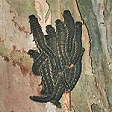 Steelblue Sawfly
Steelblue Sawfly
The adult Steelblue Sawfly (Perga dorsalis) female is steel blue in colour, with yellow antennae and legs, growing up to 20mm long, with 40mm wingspans. The insect is called a "sawfly" because of the sawing action of the ovipositor. The yellowish-brown larvae have chewing mouth parts.
Appearance of the Pest
During the day, sawflies congregate in clusters, separating at night to travel and feed on the foliage of the host plant.
Period of Activity
Caterpillars appear in spring through summer and are found from tropical to sub-tropical and temperate regions.
Susceptible Plants
There are many ornamental and Australian native plants that are attacked including Eucalyptus camaldulensis, E. blakelyi, E. melliodora, and E. pauciflora and Callistemon, Leptospermum species.
Eucalyptus species are attacked by the Eucalyptus Sawfly (Perga kirbyi) which can defoliate a tree.
Larix species are attacked by the Larch Sawfly (Pristiphora erichsonii). The adult wasp-like fly deposits eggs in an incision on the twigs during late spring and the 25mm long olive green spiny larvae chew the needles. The larvae overwinter on the ground in brown cocoons.
Melaleucas are also attracts the Paperback Sawfly.
Pinus and Callitris species are attacked by up to four species including the Pine Sawfly (Diprion simile).
Sorbus aucuparia is attacked by the Mountain Ash Sawfly (Pristiphora jeniculeta). The larvae feed on the leaves, leaving only the mid rib and main veins. Heavy infestations causes serious defoliating of the tree.
Viola species are attacked by the Sawfly (Ametastegia pallipes) which eats the leaves skeletonising them.
Damage Caused
Generally the larva eat the surface of leaves, skeletonising them when young, but as they develop they eat large pieces leaving only the mid rib. They tend to feed on the terminal shoots, and heavy infestations can defoliating young trees.
Cultural Control
Clustering larvae may be hosed or knocked from branches, falling to the ground where they can be squashed under foot or attacked by other predators. At night when the larvae congregate they can be collected and disposed off. In small infestations they can be picked by hand and destroyed.
Biological Control
The exudate causes most birds to avoid the larva, although cockatoos remove the head and oil gland prior to consumption. They are also eaten by lizards and frogs or attacked by parasitic wasps.
Chemical Control
Affected plants can be sprayed using Maldison or Carbaryl, this is only possible for small trees.
Note
Always read the label for registration details and direction of use prior to application of any chemicals.
PEST
NAME
Bag Shelter Moths
Various Bag Moths Species
ORDER
Lepidoptera
Description of the Pest
There many caterpillars that constructs a shelter that they live in and also acts as protection from predators. These caterpillars feed solitary or are gregarious emerging at night to feed. The caterpillars (larva) have chewing mouth parts.
Bagworm (Thyridopterix ephemeraeformis) adult is a moth that produces caterpillars that construct a small elongated shelter from pieces of the host's leaves and enlarges to 80mm long, as the lava grows. The eggs overwinter in an old female bag and many plants are attacked such as Thuja and Abies species.
Bluegrass Webworm (Crambus teterrellus) is the larvae of the closed winged moth. Deposited bead-like eggs hatch in 10 days and the emerging lava feed on the leaves of Turf Grass. They then construct a silken tunnelled nest close to the soil and disguised with soil, leaf fragments and droppings. The larvae pupate in a cocoon under ground for 14 days. Infested lawns such as Stenotaphrum secundatum (St Augustine) have a ragged appearance and areas may die off completely.
Forest Tent Caterpillar (Malacosoma disstria) are bluish with white diamond-shaped spots along its back, feeding solitary on leaves and unlike the Eastern Tent Caterpillar nests are not built by binding twigs together, but by surrounds a single branch.
Juniper Webworm (Dichomeris marginalla) is a small larva to 12mm long and is brown with reddish brown longitudinal stripes. They form bags by webbing twigs and needles and appear during summer. The eggs are laid by a female adult moth with a wing span of 10mm and the immature larvae overwinter.
Procession Caterpillars or also known as Itchy Caterpillar (Ochrogaster contraria) is a fleshy caterpillar that grows up to 50mm long and is named because of its procession habit when moving about head to tail. It appears banded in reddish brown stiff hairs that are long and irritate skin on contact. The adult brown moth has a wing span up to 50mm across with two spots on its forewings.
Larva constructs large obvious shelters or bags using the twigs and leaves towards the end of the branches. These bags have some stiff hairs that cause irritation, old casts and have a mud brick-like appearance.
Tentmaker (Ichthyura inclusa) adult female moth is grey wings that are white striped and produces a black larva with yellow stripes. The larvae construct silken nests by binding twigs together and feed on the surrounding leaves. Commonly found in Populus species. A simular caterpillar The Eastern Tent Caterpillar (Malacosoma americanum) is found on Cherry trees.
Webbing Caterpillar is up to 25mm long with numerous black hairs along its body and constructs shelters that incorporate stems and leaves, becoming larger as the larvae grows. The silk ties are littered with debris and excrement. The adult moth is greyish with small markings on the wings.
Life Cycle
These insects have a Holometabolous life cycle, i.e. an egg, larval, pupal and adult stage
The insect commonly pupates inside the bag, some pupate in the soil.
Distribution of the Pest
Larvae are active from mid summer through autumn, regardless of the climatic conditions.
They are found throughout coastal and inland Australia but the species vary with the climatic environment.. The moths fly to new areas aided by the wind and larva of certain species walk to a new host when the old one is depleted of food.
 Gregarious larvae
Gregarious larvae  Typical bag shelter
Typical bag shelter
Period of Activity
Larvae shelter in the bag, where they feed during the day; they leave their shelter to continue feeding at night on the surrounding foliage.
Damage Caused
Larvae eat the leaves of shrubs or trees and a heavy infestation can cause complete defoliation. Ugly bags hang or are wrapped around the plant sometimes in large numbers. The shelters can be up to 300mm across and are constructed of twigs and leaves that are curled or joined together with silken thread, commonly look unattractive.
 Leaves damaged by the larvae
Leaves damaged by the larvae
Susceptible Plants
A wide range of plants are attacked by these moths and include Brachychiton , Acacia, Baeckea , Beaufortia, Juniperus, Kunzea, Leptospermum, Melaleuca and Syncarpia species. The larva nest in the host plant or at the base and normally feed at night.
 Nest at base of Acacia spp.
Nest at base of Acacia spp.  Hairy caterpillar
Hairy caterpillar
Acer, Betula, Quercus and Populus species are susceptible to the Forest Tent Caterpillar.
Cotoneaster species are attacked by Webworm (Cremona cotoneaster) lava which skeletonises the leaves.
Turf grasses are susceptible to an infestation of Sod Webworm (Herpetogramma licarsisalis). It is a sporadic pest that appears from late summer to autumn. The adult is moth is grey-brown with black spots and has wings are up to 25mm across with transverse dark wavy lines. It flies during the night depositing eggs. The larva (caterpillars) feed on the leaves and construct a silken nest close to the ground where they live out there lives. When fully fed the larvae are up to 25mm long, green brown with dark spots displayed on its body.
Control
Cultural Control
Cut bags from the tree during daylight and destroy.
Use gloves as some bags and larvae are armed with irritating hairs.
Biological Control
Birds and lizards help keep numbers down, but these are not commercially available.
Bacillus thuringiensis a bacterial disease of insects in the order Lepidoptera applied to leaves late in the day may reduce the number of larva
Chemical Control
Systemic, contact or stomach insecticides may be effective if sprayed onto the exposed larva
Note
It is your responsibility by law to read & follow the directions on the label of any pesticide
Amendments by B. Sonsie Dip Hort Sc Burnley
PEST
NAME
Tip Borer
Various Tip Borer Species
ORDER
Various
Description of the Pest
There is many species of moths which are brown, blackish or white up to 30mm long. Generally the fleshy, greenish to cream coloured larvae grow to 25mm long and are sparsely hairy. The Callistemon Tip Borer is laid by a metallic to blackish moth and the larvae are creamy grubs that have true legs. Some larvae are very active when disturbed such as the fleshy Macadamia Twig Girdler which has darker strips on its body and a dark head.
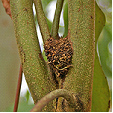 Dieback Borer Damage
Dieback Borer Damage
Dieback Borer (Platyomopsis armatula) adult is a grey-brown beetle up to 20mm long with small lumps on its wing covers and long antennae. The 15mm long cream coloured larva tunnel under the bark and feed on the sapwood causing ringbarking. The entrance to the tunnel is covered in frass and plants in the Myrtaceae family such as Eucalyptus species are susceptible.
Elm Twig Girdler (Oberea tripunctata). The adult beetle feeds on twigs causing girdling then deposits eggs during spring. The lava tunnels down the centre of the stem from the girdled point and overwinters in the tunnels. Twigs up to 14mm diameter may snap off at the damaged point and Ulmus species are normally the host.
Mahogany Shoot Borer (Hypsipyla grandella). The adult is a greyish-brown moth with a wingspan up to 45mm with the wings and veins distinctly overlayed in black. It deposits oval eggs that are tiny 0.50mm wide normally deposited in the leaf axil and change colour from white to red in the first 12 hours. In 3 to5 days the larvae emerges and can grow to 25mm long and is brownish white when young and maturing to bluish with a brown head capsule. Swietenia species are damaged as the larvae bore into the new shoots normally during spring or during the rainy season. The shoots and branches wilt then collapse. This is a major economic pest for cultivated trees.
Red Cedar Tip Moth (Hypsipyla robusta) adult is a grey moth with a wing span up to 20mm across and produces fleshy lava with true legs up to 20 mm long that tunnels into the tips of twigs. The tunnels are surrounded by webbing that is littered with pelleted droppings and is normally found on Toona species.
Staghorn Borer larvae grow to 15mm long and are greyish with true legs and the grey adult moth has a wingspan up to 20mm across. It attacks Platycerium species by eating tunnels into the sterile fronds.
Appearance and Distribution of the Pest
They are found mainly on the coast but also inland and are distributed by flying with the assistance of wind.
Life Cycle
These insects have a Holometabolous life cycle, ie. When metamorphosis is observed during the pupal stage.
Eggs are laid in bark on the growing tips. Larvae shelter in tunnels they create in the wood, up to 20mm deep.
Period of Activity
Active throughout the year in warm climates and are commonly found from tropical to sub-tropical and temperate regions.
Damage Caused
Generally the symptoms of tip borers is yellowing and curling of the leaves which wilt then die or shoots become blackened and are noticeable in the tree. Extensive feeding by a number of larvae causes dieback but normally, this is a minor pest.
The larvae emerge from their tunnels at night, to feed on the bark around the entrance holes. Entrance holes are covered by a layer of chewed wood fragments ("frass") and silk webbing. Most damage appears on twigs and new growth.
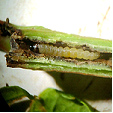 Typical larvae
Typical larvae
The Callistemon Tip Borer tunnels down the centre of the twigs causing then to die or break off and the Macadamia Twig Girdler (Neodrepta luteotactella) form tunnels in sapwood that are covered in fine webbing that is dotted in brown excreted pellets. This is the same appearance as the Banksia Web-covering Borer (Xylorycta strigata) larva makes, as it tunnels down the centre of shoots.
Susceptible Plants
Many native and ornamental plants are susceptible to tip borers such as Callistemon, Melaleuca, Banksia, Hakea, Macadamia and Stenocarpus species
Eucalyptus, Callistemon, Corymbia, Leptospermum and Melaleuca species are attacked by the Dieback Borer (Platyomopsis armatula). Twigs and small branches are attacked and the larvae causes ring bark. Affected branches break easily in high winds.
Sambucus, Yucca and Delphinium species are attacked the Common Stalk Borer (Papaipema nebris) which attacks the stems causing the plant to wilt and topple over.
Cultural Control
Larvae may be destroyed after exposure by pulling away the covering pad of frass, or by pushing a length of wire into the tunnel. Damaged branches may be removed, or tunnels plugged. Infested perennials or annuals should be removed and destroyed.
Biological Control
No effective biological control.
Chemical Control
Spray with Carbaryl (including the trunks or stems) if necessary while the insects are active.
Note
Always read the label for registration details and direction of use prior to application of any chemicals.
PEST
NAME
Christmas Beetle
Anoplognathus Species
ORDER
Coleoptera
FAMILY
Scarabaeidae
Description of the Pest
Christmas beetles are large up to 200mm (¾in) long. The adults have a stout body shape the antennae are flattened into discs. The common species Anoplognathus pallidicollis and Anoplognathus porosus have shiny buffed tan-brown elytra (wing covers) and a metallic green coloured head. Another species (Anoplognathus smaragdinus) are very showy with metallic blue, orange or green colourings. The plump larvae (commonly known as the 'curl grub') are creamy-white in colour with a dark area near the end of the abdomen.


A shiny brown adult that is found in the warmer regions of Australia and is up to 20mm long. This beetle feed on the leaves and when swarming may strip the host tree.
Life Cycle
This insect has a Holometabolous life cycle, i.e. it has a larval and a pupal stage.
The larvae pupate in the soil and the beetles emerge in summer with usually one generation per year.
The larvae can live for up to two years. Adults may live for up to a year, this varies for the species concerned.
Distribution of the Pest
Adult beetles appear in spring with the warmer weather and are found inland or on the coast from temperate to subtropical regions where large numbers attack the foliage of suitable trees. The larvae are not commonly noticed as they burrow and chew the roots of grasses or small plants. This family of insects is found world wide, including Australia.

Period of Activity
The beetles are active from spring to mid summer preferring the warmer weather and the larva feed from late summer to autumn.
Damage Caused
The beetles chew large sections out of the new leaves (a saw tooth pattern to the margin of the leaf) and shoots causing defoliation of the trees when heavily infested and repetitive attack may cause the decline of the host.
The larva eats the roots grasses and in confined situations nursery stock and container plants.
The larvas cause death of grasses as their roots have been severed from their stem. Young plants in confined situations such as pots can also suffer severe damage and may die.
The larvae have little affect on large trees and shrubs
Susceptible Plants
The adult beetles primarily attack many Eucalyptus and Corymbia species but may also be found on Melaleuca and Leptospermum species.
The lava feed mainly on the roots of grasses. The roots of vegetables can also be attacked.
Control
Cultural Control
Small infestations may be removal by hand where possible. Adult beetles can also be controlled manually by knocking them off a small plant and placing the adults into a bucket containing soapy water. Resistant cultivars or hybrids are being researched.
Maintain the vigour of the trees by addressing stress problems.
Biological Control
These insects are part of the Australian ecosystem, and have many predators if the ecosystem is healthy and diverse.
Chemical Control
There is no effective method for spraying adult beetles as they are nomadic.
The larvae may be chemically control in confined areas such as a containerised plant
Note
It is your responsibility by law to read & follow the directions on the label of any pesticide.
Monitoring
Adult beetle are attracted to lights
Amendments by B. Sonsie Dip Hort Sc Burnley
PEST
NAME
Fruit Tree Borer
Maroga melanostigma
ORDER
Lepidoptera
FAMILY
Oecophoridae
Description of the Pest
Adults are white, satiny moths with 40-60mm wingspans; their black abdomens are fringed with orange-brown hair and tufted at the tip. Larvae are reddish brown with a few hairs, up to 50mm in length.
Appearance and Distribution of the Pest
An Australian native pest that is found on the coast or inland from temperate to subtropical regions.
Life Cycle
This insect has a Holometabolous life cycle, ie. When metamorphosis is observed during the pupal stage.
Eggs are laid singly, in bark normally in the branch junctions. After the eggs hatch the larvae shelter in the shallow tunnels they create in the wood, up to 60mm deep. The tunnel entrance is closed with webbing and the lava pupates, emerging the following summer.

Period of Activity
The pest is active throughout the warmer months and the lava overwinters in its sealed tunnel.
Damage Caused
Larvae emerge from their tunnels at night, to feed on the callus tissue around the entrance holes. Entrance holes are covered by a layer of chewed wood fragments ("frass") and silk webbing. Most damage appears on the branches, especially at junctions. Extensive feeding may girdle the branch cause ring-barking.
On inspection, the wound is covered in webbing material and on removal the true extent of the damage is revealed, bear wood. These areas may be infected by wood rot fungi.


Susceptible Plants
There are many plants that are attacked by the Fruit Tree Borer including; Acacia, Banksia, Callicoma, Lagerstroemia, Eucalyptus and Jacaranda species, and flowering stonefruit.
Factors that contribute to attack are infertile poorly drained soils or damage to the bark, mechanically or from sunscald.
Cultural Control
Larvae may be destroyed after exposure by pulling away the covering pad of frass, or by pushing a length of wire into the tunnel. Damaged branches may be removed. Use correct tree surgery techniques to seal the wound.
Improve the vigour of the tree by lightly cultivating the surrounding soil then fertilise and water. It may also be lightly pruned to encourage new growth.
Biological Control
No effective biological control, but several parasites and predators keep the numbers down.
Chemical Control
Spray with Contact insecticides (including the trunks).
Note
Always read the label for registration details and direction of use prior to application of any chemicals.
PEST
NAME
Jewel Beetles
Various Jewel Beetle Species
ORDER
Coleoptera
FAMILY
Buprestidae
Description of the Pest
There are many species of Jewel beetles and generally have flat and elongated bodies with metallic, iridescent-patterned shells in orange red or yellow. The plump larvae are cream-coloured legless grubs, shaped like a cobra head with a large body segment behind the head.


Appearance and Distribution of the Pest
They are common throughout Australia particularly in the drier regions.
Life Cycle
This insect has a Holometabolous life cycle, ie. When metamorphosis is observed during the pupal stage.
Eggs are laid in cracks in the bark of the host, upon which the mature larvae pupates.

Period of Activity
Most active from spring through summer.
Damage Caused
The larvae feed beneath the bark, producing oval (in cross-sectioned) tunnels with much sawdust ("frass") around the entrance. The larvae burrow into the cambium layer. Stressed or damaged plants are more susceptible to infestation and may display branch die-back; occasionally the larvae may ring-bark the trunk.
Susceptible Plants
Many plants are attacked especially in the Myrtaceae family such as the Eucalyptus, Leptospermum and Melaleuca species. Allocasuarina are also attacked.
Banksia species may be attacked by the Banksia Borer (Cyria imperialis).
Cupressus species are attacked by the Cypress Jewel Beetle (Diadoxus erythrurus).
Cultural Control
Remove damaged branches or repair using arboriculture techniques. Improve the culture of the plant.
Biological Control
No effective biological controls.
Chemical Control
No practical chemical control of the larvae is available. Tree injection is unsuccessful because the larvae tunnel into the woody part of the plant.
Note
Always read the label for registration details and direction of use prior to application of any chemicals.
PEST
NAME
Nectar Scarabs
Phyllotocus species
ORDER
Coleoptera
FAMILY
Scarabaeidae
Description of the Pest
Adult beetles have a characteristic scarab shape, up to 6mm in length, with exaggerated hind legs. The head and thorax is dark brown; the wings have orange-brown longitudinal striations. Larvae appear as small white curl grubs. Both larvae and adults have chewing mouth parts.
Flower Scarab Beetles (Protaetia apecies). Thiese active beetles are stout and broad up to 20mm long. The colouring is normally brown with some having small pale markings on the wing covers. It is commonly found feeding on Myrtaceae or Proteaceae flowers (pollen) or shoots of Acacia species. It is a solitary feeder and may cause dieback of the host.
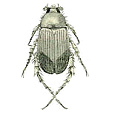
Appearance and Distribution of the Pest
Nectar scarabs are Australian natives but are rarely found in the Northern Territory. They are distributed by flying to a new host plant.
Life Cycle
These insects have a Holometabolous life cycle, ie. When metamorphosis is observed during the pupal stage.
It has a complete metamorphosis producing one generation every one to three years, depending on the species. The eggs are laid during spring normally near the surface of the soil and the lava burrow into the soil. The lava overwinters deep in the soil and pupates during spring.
Period of Activity
Most active during the warmer months, when plants are flowering.
Damage Caused
Larvae feed on decaying vegetable matter and cause little damage. Adults swarm on host plants in large numbers, feeding on pollen and nectar; when swarming they may also feed on the flower parts.
Susceptible Plants
Many plants are attacked by this insect including Acacia, Eucalyptus, Melaleuca and Callistemon species. Ornamentals such as Rosa and Dahlias species are also attacked.
Cultural Control
Small infestations may be removed by hand but certain species such as the Flower Scarab Beetle drop to the ground and pretend to be dead. This is an opportunity to collect them on a piece of plastic if it is spread around the plant.
Biological Control
No known controls.
Chemical Control
Contact insecticides such as Carbaryl are effective, but not normally necessary.
Note
Always read the label for registration details and direction of use prior to application of any chemicals.
PEST
NAME
Case Moths, Bag moths
Various Case Moth
Species
ORDER
Lepidoptera
FAMILY
Psychidae
Description of the Pest
Also called the bag moth or bagworm - so called because of the silken, bag or case-like structure in which they shelter and pupate. The pendant case is frequently covered with twigs, pine needles, sand or leaf fragments, which serve to reinforce and camouflage it. The case is enlarged as the caterpillar grows and the upper part of the body emerges for feeding and movement. It withdraws into the case if threatened or disturbed.
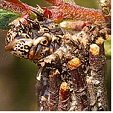 Case moth feeding
Case moth feeding 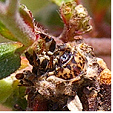 The head protrudes from the case to feed
The head protrudes from the case to feed
Leaf Case Moth (Hyalarcta huebneri) constructs a short cocoon that has a ragged appearance and is covered in leaf and bark pieces. The caterpillar is orange with black bands and can grow to 50mm (2in) long. This pest can be found on Eucalyptus and Leptospermum species, it may also attack palms from sub tropical to tropical regions.
Ribbed Case Moth (Hyalarcta nigrescensi) forms a greyish cocoon that has four prominent ribs and taper at the base. It feeds solitary on Acacia and Eucalyptus species by chewing on the leaves or removing the epidermal layer of the leaf.
Saunders Case Moth (Metura elongatus) forms an elongated silken bag composed of small pieces of twig and is up to 150mm (6in) long. The caterpillar is dark red with yellowish bands and markings. It is commonly seen from temperate to tropical regions feeding on leaves of Eucalyptus, Callistemon and Epacris species. When disturbed it hides in its cocoon and control is not normally required.
 Saunders Case Moth
Saunders Case Moth 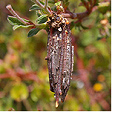 Ribbed Case Moth
Ribbed Case Moth
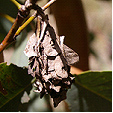 Leaf Case Moth
Leaf Case Moth 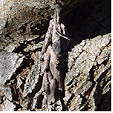 Well Camouflaged
Well Camouflaged
Life Cycle
This insect has a Holometabolous life cycle, i.e. it has a larval and a pupal stage.
The larval stage can last up to 2 years.
The male moths can fly. In some species the females are wingless, or have greatly reduced wings.
In some species the females can lay over 10,000 eggs.
Larvae pupate in their cases. Newly hatched larvae disperse and construct their own cases.
Distribution of the Pest
They are widespread across most temperate to tropical Australia.
Damage Caused
Larvae eat leaves and on masse they may cause considerable damage.
Larvae and their cases are difficult to detect among foliage.
Period of Activity
Larvae are more numerous and active during the warmer months.
Susceptible Plants
A wide range of plants are susceptible to case moth larvae, with different moth species favouring different plants. Host plants include eucalypts, acacias, pines and conifers.
Callitris species are attacked by the Stick Case Moth (Clania ignobilis) that constructs a cylindrical cocoon of aligned twigs with a projecting twig at the base and feeds on small or young foliage. It is not a major pest causing little harm.
Larix species are attacked by the Larch Casebearer (Coleophora laricella). The caterpillar forms a cigar-shaped case from pieces of needles. It feeds on the needles in late spring by forming a hole either end or the middle of the leaves and mining the centre with out leaving its case. It then overwinters in its case attached to the twigs and the moth emerges in early summer.
Control
Cultural Control
Early detection and control of infestation is important with some species; they may be removed by hand.
Biological Control
Birds are natural predators.
Chemical Control is possible, but this is not usually necessary.
Note
It is your responsibility by law to read & follow the directions on the label of any pesticide
Amendments by B. Sonsie Dip Hort Sc Burnley
Note: Plants affected by this pest are Deer Resistant plants not the susceptible plants.
PEST
NAME
Deer
Cervus species
ORDER
Artiodactyla
FAMILY
Cervidae
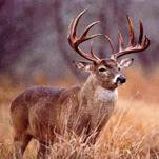
Description of the Pest
There are two species of the deer in North America, the Whitetail (Odocoileus virginianus) and the Mule deer (Odocoileus hemionus) with several regional variations such as the Pacific coastal Blacktail (O.h. columbianus) which is regarded as a sub-species of the Mule deer.
The Whitetail on average grows to 112 cm (44in) tall and 180 mm (70 in) long and weigh 68 kgs (150lbs). The fir colour varies according to its environment but generally it is reddish-brown during summer and grey-brown in winter with a pure white underside on its tail. When the tail is erect it is known as the "white flag". Its antlers consist of two main beams from which the points emerge.
The Mule deer grow to 105 cm (42 in) tall and are up to 200 cm (80 in) long with the adult buck weighing up to 137 kgs (300 lbs) and the does up to 80 kgs (175 lbs). The fir is generally tawny brown during summer and during winter it has a heaver grey-brown to blue-grey coat with a small white tail that is tipped in black. The other distinguishing features are its ears that are up to 300 mm (1 ft) long (mule-like) and its antlers, with the two beams that are forked into smaller beams, which inturn fork again and again.
The Blacktail deer (Pacific coastal Blacktail) grows to 97 cm (38 in) tall and is up to 105 cm (60 in) long and weighs on average 73 kgs (160 lbs). The fir is generally tawny brown during summer and during winter it has a heaver grey-brown to blue-grey coat with a tail that is dark brown at the base then changing to black for 50% of its length. The antlers consist of two beams that are forked into smaller beams, which inturn fork again and again.
Appearance and Distribution of the Pest
The Whitetail deer are found throughout eastern United States, on the coast and inland but are not commonly seen in California, Utah or Nevada. They do not migrate but congregate together (yard up) during winter and feed in a part of their existing territory.
The Mule Deer are found in the western part of North America from South eastern Alaska to Mexico and from the Pacific coast to Texas. They migrate from highland mountain meadows to southern or lower snow free forested valleys during winter.
The Blacktail deer are found on the Pacific coast from Alaska to northern California. There is both resident and migratory Blacktails. The migratory Blacktails move southwards during late autumn at the first sigh of snow or heavy sustained rain and the resident Blacktails seek cover their existing territory amongst woodlands during the winter months.
Life Cycle
All Deer breed from autumn to early winter and the does give birth from late spring to early summer.
Period of Activity
Deer are most active from spring to autumn but can be troublesome during winter when the feed is scarce. In some regions urban landscapes become the major food source both in summer and winter.
Damage Caused
Browsing deer will feed on almost any plant and is most commonly noticeable during spring feeding on the new growth or twigs and stems leaving a shredded appearance. Deer also rub their antlers against trees damaging bark and snapping off small branches, this action also incurs damage under hoof as plants, lawns and garden structures are trampled on.
Susceptible Plants
Some plants are more palatable to deer but when a deer is hungry or during drought conditions there are no "Deer Proof" plants. There is a range of plants that have a bad taste and are not destroyed and are regarded as (deer resistant plants). Deer resistant plants are the plants that are attached to this file not the susceptible plants.
Cultural Control
There are many cultural controls that have been tried to move browsing deer such as frightening them with strobe lights, pyrotechnics or tethered savage dogs. These actions are only temporary and may cause more trouble as the stampeding animals move off. Fencing and netting can be an effective method of discouraging hungry deer from gardens but may be expensive on a large scale and require maintenance. There are several types of fences which include conventional 2.2m (8 ft) deer-proof woven wire fences or single-wire electric fences and slanted deer fences. Plant selection can also be effective, by using less desirable plants (deer resistant plants) as an outer border to the more desirable plant species and thus discouraging the deer to enter the garden. Hedges and windrows of less desirable thorny plants can also be a deterrent to browsing deer.
Chemical Control
There are two main types of repellents contact and area. Contact repellents are applied directly to the plants and deter deer with a bad taste or smell. They can be applied by rubbing or spraying on to the plants and commonly used in an egg mixture. The commercial products have proven to work better than home remedies which include soap or chilli mixtures and hanging bags of human hair.
Area repellents rely on an offensive odour and are placed around areas that are frequently visited.
Contact your local distributor for available types and application.
DISEASE
NAME
Fungi (General)
Various Fungal species
Description
A fungus is a plant that lacks chlorophyll and conductive tissue. Generally they are made up of branched threads called 'hyphae' and collectively form a vegetative body called 'mycelium'. The fungus is small but the fruiting bodies can become very large up to 600mm across such as bracket fungi or mushrooms. Common fungi are mould and mildews. problem that attacks the roots causing them to rot.
Fungus can reproduce many ways but primarily it is asexually, simular to cuttings of a plant and often occurs with minute portions of the mycelium (spores) separating. The spores can be arranged in a structure such as a sporangia or pycnidia or develop without an enclosed structure called a "conidia". Either way the fungus propagates very rapidly. Sexually reproduction occurs when two nuclei unite and form sexual fruiting bodies (zygospore).
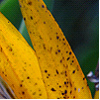 Strelitzia reginae flower
Strelitzia reginae flower
Symptoms
Fungus attacks all the above or below ground level parts of the plant living within the tissue of the plant and are very small and not normally detected until the fruiting body appears. However parasitic types such as powdery mildew or rust are visible on the outer surface of the plant.
Fungi hyphae may be divided by cross walls and known as "septate" while others with no cross walls are known as "nonseptate". These are the fungi responsible for cell leakage as in rot.
Back Mold (Chalariopsis thielavioides) affects understocks of grafted Rosa species by inhibiting the development of callus. It is whitish-grey maturing to black and can be found in the pith of the rose stem.
Black Root Rot (Chalara elegans).This recently introduced fungal disease in Australia (1993) affect plants by blackening the root systems and turning leaves yellow or purple. It is difficult to identify specifically as other pathogenic root diseases and nutritional deficiencies have simular characteristics.
The asexual spores are dispersed by wind or water. It is also transmitted on insects and in contaminated growing media or plants preferring humid moist conditions.
This fungus affects a wide range of ornamental plants including; annuals, perennials and shrubs. Examples are Begonia, Boronia, Camellia, Cyclamen, Fuchsia, Gerbera, Grevillea, Impatiens, Pansy, Petunia, Rosa species and Snapdragon.
Black Stem Rot (Pythium splendens) normally is a rot that occurs in cuttings turning the stem progressively black and shrunken. The leaves fall and the plant becomes stunted, eventually dieing.
Bleeding Necrosis (Botyosphaeria ribis) attacks and kills the inner wood causing the bark to split open and bleed sap giving it an oily appearance.
Blight (Endothia parasitica) is a serious pest of Castanea species, entering the twigs and small branches, and then progressively travelling throughout the tree killing it. It may form cankers on the base of the trunk or in the dead branches above with the amber coloured fruiting bodies pushing there way through the bark.
Copper Web ((Rhizoctonia crocorum). This fungal disease appears in defined patches causing the corms in the centre to become a black powdery mass. Corms on the outer ring of the patch that are partially infected forming a felty mass of violet threads on the corm scales. These threads extend into the soil and large sclerotia forms in the soil and on the corms. Healthy corms become infected from contaminated soil that contains mycelium and sclerotia.
Dry Rot (Phyllosticta concave) forms small circular spots that increase to a diameter of 30mm, and then becomes sunken as the cells collapse. The infected area develops minute black fruiting bodies.
Dutch Elm Disease (Ceratocystis ulmi) is a serious fungal problem of Ulmus species that initially causes yellowing then wilting of the leaves that turn brown and die. This may be seen on certain branches of the tree and on inspection under the bark the sapwood reveals brown streaks. A cross section of the affected branch displays round spots that are dark brown. This infection normally spreads quickly throughout, killing the tree in one to two seasons.
Dieback in Camellia (Glomerella cingulate) is a pathogenic fungus that infecting existing wounds such as leaf scars or mechanical damage, forming a sunken area (canker) that spreads around the stem causing die back. The affected plant has new shoots that are brown-black and the tips curl, forming a 'Shepard's Crook' appearance. The leaves also die but are persistent on the plant and the spores are found in soil or on other infected plants.
Curvularia Leaf Spot (Curvularia species) in Turf Grass. This is normally a secondary weak fungal infection that forms spots on the leaves that lengthens turning the leaves greyish. The leaf shrivels then dies and infected areas appear as weak patches in the turf. Preventive measures include minimising leaf wetness and excessive use of nitrogen fertiliser.
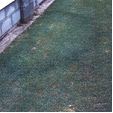 Fairy Rings Blue Couch
Fairy Rings Blue Couch 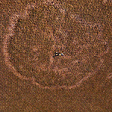
Fairy Rings are a fungal problem in Turf Grass and is caused by several species including (Lycoperdon species), (Marasmius species) and (Tricholoma species). Rings appear in the turf as fruiting bodies or dead grass and as lush green foliage. The mycelia expand radially in the turf feeding on soil nutrients and organic matter with water present.
Under severs conditions the mycelia consume all available nutrients resulting in the death of the turf. Lush turf can result from a less developed infection, where the decomposing hyphal releases nitrogen. This available nitrogen may be beneficial to the turf but some forms of nitrogen are detrimental.
Leaf Blister (Taphrina coerulescens) appears as yellowish circular raised areas on the upper side and depressions on the underside of leaves, up to 15mm across. As the fungus spreads the leaf dies but remains attached to the tree and this infection is commonly found on Quercus species..
Leaf Blotch (Guignardia aesculi) forms small or large water soaked spots that are reddish with a bright yellow margin and form black fruiting bodies in the centre. The affected leaf and petiole have a scorched appearance before falling, found on Aesculus species
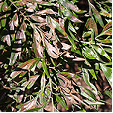 Grevillea robusta
Grevillea robusta 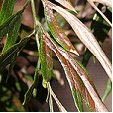 Leaf Scorch
Leaf Scorch
Leaf Scorch (Verrucispora proteacearum) is a fungal disease that infects leaves causing large parts of the leaf to turn grey-brown, giving the appearance that it has been singed by fire. Black fruiting bodies appear on the affected areas and the leaf soon withers then dies. New, mature leaves are affected during very wet periods towards the end of the branches and Grevillea and Hakea species are susceptible.
Melting Out (Helminthosporium vegans) forms bluish black spots with straw coloured centres on the leaves and may be found on the sheath, encircling it causing Foot Rot. It infects grasses particularly Poa pratensis. There is another fungus that is simular Helminthosporium Blight (Helminthosporium dictyoides) that infects Poa, Festuca and Agrostis species.
Pad decay (Aspergilus alliaceus) infects Cereus and Opuntia species and occurs at during periods of high temperature. The yellow spores at the epidermal layer through wounds and germinate on mass causing the area to become soft and spongy. An anthracnose called Shot Hole is a similar forming brownish spots the turn grey, and then black destroying pads. Control methods include physically removing damaged pads and allowing the Sun to heal wounds.
Potato Gangrene (Phoma foveate) is a soil borne fungus that infects the roots during harvest primarly through wounds and develops during storage. The potatoes rot from the inside forming rounded depressions on the surface and have a strong odour of rotten fish.
Root Rot Fungi (Phymatotrichum omnivorum) and (Pellicularia filamentosa) cause the roots to rot and the plant suddenly wilts then dies.
Root Rot (Pythium debaryanum) forms water soaked dark brown streaks that affect all parts of the plant causing wilting then dieing. It infects Ranunculus species, it also infects cactus species by forming brown spotting and wilting that appears at the base of the plant then extends towards the top. It quickly spreads from plant to plant in collections and is controlled by avoiding over watering, excessive humidity and are using a sterilised soil when potting up.
This fungus also is responsible for damping off of seedlings in a glasshouse environment.
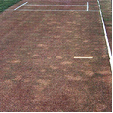 Spring Dead Spot
Spring Dead Spot 
Spring Dead Spot (Leptosphaeri species) is a fungal disease that infects Couch Grass. It first appears during autumn as pale bleaches areas up to 500mm (20in) wide and persists throughout winter. In spring the affected areas do not recover or recover slowly and on inspection the roots or rhizomes are rotted. Runners from the surrounding healthy turf will help with recovery and all signs of the problem disappear by mid summer.
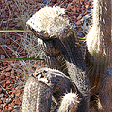 Cactus species
Cactus species 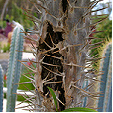 Pachypodium species
Pachypodium species
Stem Rot (Helminthosporium cactivorum) forms well defined yellow lesions that mature into soft dark brown rot. It commonly infects Cactus species entering through the stomates or wounds. Heavily infected plants collapse and die.
Stem Rot or Basal Rot (Pellicularia rolfsii) is a soil borne fungus that infects the stem root junction and extends into the leaves. In orchids the leaves become discoloured, dry and detach from the base which is covered in a fungal growth that produces sclerotia. The sclerotia is whitish to yellow then becoming dark brown and can be viable for up to four years.
White Mold (Ramularia desta f. odorati) occurs on both sides of the leaf and looks simular to powdery mildew but forms faint dull, reddish brown elongated spots on the leaf that may be depressed or along the margin where they have a watery appearance. Tufts of hyphae develop in the stomates.
Wilt (Ceratocystis fagacearum) causes leaves to curl then turn brown and the sap wood may also turn brown or black. Heavy infection may kill a tree within two seasons and is found on Quercus species and other ornamental trees.
Witches Broom may be a fungal problem that causes a proliferation of small axillary shoots to appear at the end of the branches. Little is known about this problem, though it affects a wide range of plants including Eucalyptus, Leptospermum and Pinus species.
Source and Dispersal
Fungus is found in the soil or on other infected plants and after releasing the spores, they are dispersed by wind or are transmitted in infected stock, insects and with splashing water.
Wilt is transmitted by infected root stocks, several species of insect and contaminated tools.
Dutch Elm Disease is transmitted by bark beetles such as (Scolytus multistriatus) and (Hylurgopinus rufipes). These beetles deposit eggs in the sapwood where the lava tunnel and pupate. The emerging beetles tunnel the bark and carry the fungus to fresh feeding sites on the tree. Infected beetles may also be transported to fresh sites in waist material.
Favoured Conditions
Prefers cool moist conditions with temperatures from 10º to 25ºC and is more common from autumn to spring when it is wet.
Affected Plants
A wide range of plants and all parts can be infected by various fungal diseases. Bleeding Necrosis is found in Liquidambar species and Stem Rot or Dry Rot infects Cactus species such as Opuntia and Pelargonium.
Abies species are infected by several fungi that cause Leaf Cast which turn the needles yellow to brown then fall prematurely.
Abutilon species are infected by the Stem Rot (Macrophomina phaseolin) affecting the lower stems and is not commonly seen.
Achillea, Cuphea, Leucanthemum, Euphorbia species are infected by the Stem Rot (Pellicularia filamentosa) which enters through the roots and rots the base of the stem.
Alternanthera species are infected by the Leaf Blight (Phyllosticta amaranthi) which forms small brown spots on the leaves causing them to curl and die.
Aloe, Astrophytum, Copiapoa, Echinocactus, Espostoa, Ferocactus, Gymnocalycium, Kalanchoe and Schlumbergerera species are infected by Bipolaris Stem Rot (Bipolaris cactivora). This infection affects many cacti species causing rot in the stems with a blackish appearance.
Amelanchler is affected by the Witches Broom (Apiosporina collinsii).
Antirrhinum species are infected by the Blight (Phyllosticta antirrhini) that forms light brown spots on the upper-side of the leaf and on the stem. As the spots enlarge they turn greyish with black fruiting bodies in the centre, then become brown and killing the affected areas.
Begonia species are infected by the Stem Rot (Pythium ultimum) turning stems black then becoming soft and causing the plant to collapse. This is the same fungus that causes Damping-off.
Betula species are affected by the Leaf Blister (Taphrina bacteriosperma) which curls the leaves and forms reddish blisters.
Chamaedorea and other cain-like species are infected with Gliocladium Stem Rot (Gliocladium vermoseni) which forms a dark basil stem rot generally on damaged plants and produces orange-pink spores. The mature leaves are first affected and eventually the stems or cains rot and die.
Crocus and Gladiolus species are infected by the Dry Rot (Stromatinia gladioli), which causes lesions on the corms and rots the leaf sheath.
Crocus, Iris, Tulipa, and Narcissus species are infected Copper Web ((Rhizoctonia crocorum).
Dianthus species are infected by Phialophora Wilt (Phialophora cinerescens) that causes the leaves to fade and plants to wilt. There is obvious vascular discoloration which is very dark. It is not found in Australia.
Erythrina x sykesii may be infected by the Root Rot Fungi (Phymatotrichum omnivorum).
Fern species are infected by Tip Blight (Phyllosticta pteridis). This blight produces ash-grey spots with purple brown margins and the fruiting bodies appear as black pimple like spots. It is transmitted by air or moisture and in infected fronds become brown and die. Control methods include sprang fungicide on leaves or reducing humidity and avoid wetting the fronds.
Forsythia species are infected by Stem Gall (Phomopsis species). It forms rounded growths along the stems causing them to die and look unsightly.
Gladiolus species are infected by Penicillium Rot of Corms (Penicillium gladioli). This disease forms deeply sunken reddish brown areas that become corky and produce a greenish fungal growth.
Hedera species are susceptible to several Fungal Leaf Spots including (Glomerella cingulate), (Phyllosticta concentrica) and (Ramularia hedericola). All of which cause yellowish spots that develop into dry brown blotches that kill the leaf.
Larix species are susceptible to Leaf Cast (Hypodermella laricis). This fungus attacks the needles and spur shoots turning them yellow at first then brown after which small black fruiting bodies appear on the leaves during winter.
There are several other fungi including (Cladosporium species) and (Lophodermium laricis) cause leaf blight or leaf casts.
Orchids such as Cattleya, Cymbidium, Cypripedium, Dendrobium, Epidendrum, Oncidium, Paphiopedilum, Phalaenopsis and Zygopetalum species are infected by Phomopsis Rot (Phomopsis species). This fungal problem forms a firm brown rot that appears on the leaves, pseudobulbs and rhizomes. The affected areas have yellow margins and the centre is covered in tiny black specks (fruiting bodies). Cattleya species are particularly susceptible. These plants are also infected by Psudobulb Rot (Mycolleptodiscus coloratus implicated). Dark spots appear on the pseudobulbs eventually causing extensive rot and killing the bulb.
Palms are infected by the fungus Butt Rot (Ganoderma sulcatum). The fungus entered the lower trunk normally as a result of mechanical damage (lawn mower). Symptoms include stunting of new growth and yellowing of the lower leaves. Fruiting bodies become evident at the base of the trunk. There is no effective control method and replanting in infected soil should be avoided.
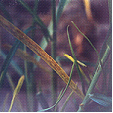 Kikuyu Yellows
Kikuyu Yellows 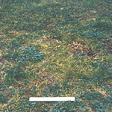
Pennisetum clandestinum (Kikuyu) is susceptible to Kikuyu Yellows (Verrucalvus flavofaciens), thisis a water mould that infects the roots and causes them to rot. The infection extends up the stem and onto the leaves with yellow discolouration and can be limited to a small or large area up to 1m (3ft) wide.
It is found in warm temperate to sub tropical regions and dispersed in infected soil or plant material. There is no chemical control, nitrogen fertiliser masks the symptoms and complete fertiliser encourages stronger roots to fight the disease.
Pittosporum, Antirrhinum, Aquilegia, Echinops and Orchid species are infected by the Stem Rot or Basal Rot (Pellicularia rolfsii) commonly in the northern hemisphere and preferring humid glasshouse conditions.
Solidago species are infected by the fungal Scab (Elsinoe solidaginis) which covers the leaves and stunts the growth of the plant. Young plants may be killed.
Trillium species are infected by the stem rot (Pellicularia rolfsii) and ( Ciborinia trillii). This normally occurs in wet soils and is detrimental to the plants life.
Tsuga species are infected by Sapwood Rot or Butt Rot (Ganoderma lucidum) and (Coniophora puteana), which attacks the sapwood close to the bark, towards the base of the tree. Commonly killing the host.
Tulipa species are affected Blue Mold (Penicillium species) and the fungus (Rhizopus stolonifer) causing rot in the bulbs.
Vinca species are infected by the soil born Root Rot (Pellicularia filamentosa) which rots the stems and roots.
Viola species may be infected with the Scab (Sphaceloma violae) which attacks all parts of the plant including the seed capsule forming yellowish spots that turn brown and in leaves fall out. Stems and petioles can be girdled killing the upper part.
Viola species are also infected with the Stem Rot (Myrothecium roridum) which attacks the stems at ground level causing them to become dry and brittle. The leaves show symptoms by turning purplish-black and this fungus also infects Alcea and Antirrhinum species.
Non-chemical Control
Generally remove and destroy any infected plants or plant parts, when replanting, avoid using susceptible species for 3 years. When growing crops space the plants to reduce the humidity and airflow and cultivate the soil to increase the drainage. Remove weed growth from around the susceptible plants.
Avoid over watering the surrounding soil which encourages fungal development. In the case of trees remove any infected branches and heavily infected trees should be cut down and removed. This infected material should be disposed or burnt. Damaged trees should have the wounds dressed and sealed as a preventative measure particularly for Dieback in Camellia.
Deter Potato Gangrene by planting clean stock and be careful not to damage the crop when weeding. When harvesting the tubers choose a dryer period and be careful not to damage them.

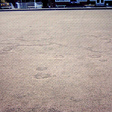 Fairy Rings
Fairy Rings
Fairy Rings in Turf are difficult to control and may appear or disappear sporadically. Cultural practice such as minimal thatch build-up, regular aeration and a reduction of organic matter spread on the turf will reduce infection.
Chemical Control
No suitable fungicides available, though drenching or spraying the soil with the fungicide dichloran helps control soil born fungi.
Note
Always read the label for registration details and direction of use prior to application of any chemicals.
DISEASE
NAME
Rust (General)
Various Rust Species
Description
Generally this fungal problem involves many species causing a range of symptoms, but generally produces pustules that release reddish - brown spores. Most fungus is specific to its host and normally will not infect other plant species.
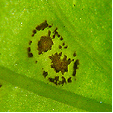 Pustules
Pustules
Symptoms
The upper leaf surface develops red, brown or yellow areas and the underside produces bright yellow to orange spores that correspond to the patches above. Infested leaves become brown in patches, fall prematurely and flower and fruit may also be infected. This overall, results in a loss of vigour and in small plants may lead to death.
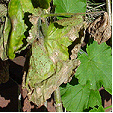 Pelargonium x hortorum
Pelargonium x hortorum
Myrtle Rust (Puccinia psidii) This fungal disease infects plants in the Myrtaceae family and was only recently detected in 2010 and has since spread across eastern Australia from the Northern Territory to Queensland, NSW, Victoria and Tasmania. This rust attacks soft and actively growing foliage or shoots with varying symptoms. It normally starts as small purple spots on the leaves from which spores form in yellow pustules that fade to grey as the infection matures and can merge creating leaf distortion and death of the plant.
The life cycle starts when the powdery yellow spores are distributed by wind to other plants where they germinate and start to grow by piercing the plant cells to obtain nutrients. Germination occurs in dark moist positions with a temperature between 15° to 25°C and the new pustules can release spores in 10 to 12 days, (spores remain viable for 3-months). The spores spread rapidly by wind, water, insects or animals. They are also distributed by plant material, clothing, shoes and vehicles.
 Puccinia psidii
Puccinia psidii
Needle Rust (Melampsora farlowii) infects the new leaves turning them to yellow and fall from the shoot giving the branch a scorched appearance. The fruiting bodies are found on the underside of the leaf and is waxy-red.
Rust in Poplar (Melampsora species). A fungal problem involving at least two species (Melampsora medusae) and (Melampsora larici-idaei).
The upper leaf surface becomes flecked with yellow to light green and the underside produces bright yellow orange spores that correspond to the patches above. Infested leaves become brown in patches, fall prematurely and shoots may die back as a result of not being hardened off to the elements. This overall, results in a loss of vigour and in small plants may lead to death.
The source of the fungus is from other infected plants or fallen leaves and is dispersed by wind.
Host plants include Lombardy Poplars particularly Populus nigra 'Italica' and cottonwoods.
White Rust (Albugo candida) forms snow white pustules that contain colourless spores that turn yellow then brown and are found on the underside of leaves.
White Pine Blister Rust (WPBR) is caused by the fungus (Cronartium ribicola). It is a obligate parasite requiring a living host to survive. The life cycle requires two host species with part of it life on the Pinus species and the other part on Ribes species. First cankers or sores appear on the Pinus species realising spores that land on the Ribes species infecting it. The infection produces a different type of spore that land on the needles and growing branches of the Pinus species and eventually forming cankers. The spores are spread by wind and prefer cool moist conditions. Symptoms include brown spots on the needles and the appearance of dead branches in the crown. Cankers will also appear on the trunk and it tends to attack young trees. Control methods include removal of Ribus species in the affected areas and breading naturally resistant Pinus species.
The Rust (Endophyllum sempervivi) affects Sempervivum species by infecting the young leaves and eventually the crown. The mycelium then travels to the roots and extends into any off shots. Leaves that are infected turn yellowish, grow longer and are thin. Persistent infection may kill the plant.
Source and Dispersal
The source of the fungus is from other infected plants or fallen leaves that contain the fruiting bodies and is dispersed by wind.
Favoured Conditions
Generally rust is more prevalent during summer, preferring warm humid conditions and particularly when the leaves are damp.
Affected Plants
A wide range of ornamental annuals, perennials, ferns, trees, shrubs including, Hibiscus species that are infected by Kuehneola malvicola predominantly in southern USA.
Abies species are infected by many types of rust including (Milesia fructuosa) and (Uredinopsis mirabilis).
Abutilon, Phymosia and Alcea species are infected by the rust (Puccinia heterospora).
Alnus species are occasionally infected with Leaf Rust (Melampsoridium hiratsukanum) which forms yellowish pustules on the leaves that develop turning the leaf brown.
Amelanchler species and Calocedrus decurrens are infected by several rust species including (Gymnosporangium libocedri).
Antirrhinum majus (Snapdragon) is infected by the rust (Puccinia antirrhini). This fungal problem that infects the epidermal layer on the leaf underside, forming pale green areas that are raised and split open revealing reddish brown spores that have a dusty appearance.
As the infestation grows, concentric rings of spore pustules appear around the original infection. The corresponding position on the upper leafs surface turns yellow eventually causing the leaf to wilt and die. The infestation is not restricted to the leaves; all above ground parts of the plant are susceptible and infected plants transmit the fungus dispersing it by wind.
Infected plants should be removed and destroyed.
Anemone and Prunus species are infected by the rust (Tranzschelia pruni-spinosae) that stimulates abnormal growth in the plant during spring.
Aquilegia, Anemone, Delphinium and Clematis species are infected by the Rust (Puccinia rubigo-vera var. agropyri).
Arctostaphylos manzanita is infected by the rust (Pucciniastrum sparsum) occurring in coastal regions but is not normally detrimental to the plant.
Artemisia species are infected by the rust (Uromyces ari-triphylli) which is a systemic disease that is transmitted through seeds. It causes the leaves to turn yellow then die and can infect all parts of the plant except the roots.
Bambusa species are infected by the rust (Dasturella divina) which forms elongated brownish strips on the leaves.
Berberis species may be infected by the Rust (Puccinia graminis) that forms orange spotting on the leaves. It certain regions plants infected with this rust must be removed and destroyed to avoid infecting neighbouring agriculture crops.
Betula species may be infected by Leaf Rust (Melampsoridium betulinum) that forms reddish-yellow spots on the leaves and heavy infestation can defoliate the tree. The host tree changes to Pseudolarix species during the sexual stage and causes blistering of the leaves.
Calendula species may be infected by the Rust (Puccinia flaveriae).
Callistephus and Solidago species may be infected by the Rust (Coleosporium solidaginis) which forms bright yellow spots particularly on new foliage or young plants.
Canna species may be infected by the rust (Puccinia Thaliae).
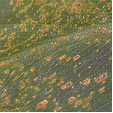
 Canna indica
Canna indica
Centaurea species are infected by the rust (Puccinia cyani) and (Puccinia irrequisita) which can cover the stems and leaves.
Cleome species are infected by the rust (Puccinia aristidae) but rarely requires control.
Dianthus species are infected by the rust (Uromyces dianthi) which forms powdery brown spots that appear on both sides of the leaves. The leaves curl and die and the plant becomes stunted. This is a common problem that occurs when grown in a protected enclosure (hot house).
Ficus species are infected by the rust (Cerotelium fici) which forms small brown spots, and causes the leaves to turn yellow then fall prematurely.
Fuchsia species are infected with (Pucciniastrum epilobii). This fungus caused purplish red blotches on the upper leaf surface, that become dry in the middle and result in a brown patch with purple edges. On the underside of the leaf, corresponding to the patches, yellow orange spores form. Heavily infected leaves become yellow and drop prematurely. This leads to a loss of vigour in the plant and infected plants transmit the fungus.
Certain cultivars are more susceptible than others, particularly 'Orange Drops' and 'Novella'.
Hydrangea species is infected by (Pucciniastrum hydrangeae) causing yellowish brown pustules to appear on both sides of the leaf. The leaf becomes dry and brittle.
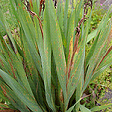
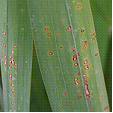 Iris species
Iris species
Iris and Dietes species are very susceptible to the rust (Puccinia iridis). Leaves form rusty red powdery spots that enlarge. They are appear on both sides of the leaves causing the surrounding area to turn pale yellow then brown and the black spores appear soon after, overwintering on dead infected leaves. Plants may be heavily infected but normally survive attack.
Larix species are infected by several Needle Rusts including (Melampsora paradoxa), (Melampsora medusae) and (Melampsoridium betulinum). The fungi attacks the needles predominantly towards the branch tips turning them yellow and eventually killing them . The underside of the leaf develops pale yellow fruiting bodies.
Lupinus species are infected by three species of rust including (Puccinia andropogonis var onobrychidis).
Malus andChaenomeles species may be infected by the rust (Gymnosporangium juniperi-virginianae) or (Gymnosporangium clavipes) which forms brown or bright orange spots on the leaves or twigs and can defoliate the tree. Juniperus virginiana and Mespilus germanica may also be infected by rust.
Mathiola and Arabis species are infected by White Rust.
Pinus species are infects by the Comandra Blister-rust (Cronartium comandre).
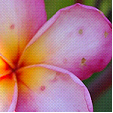
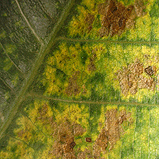
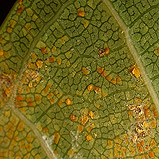
Plumeria rubra Leaf upper surface Leaf underside
Plumeria species are susceptible to the rust (Coleosporium plumeriae). Leaves and flowers may be infected with the underside forming bright yellow pustules and causes premature leaf or flower drop.
Populus nigra 'Italica' is infected by the rust (Melampsora species) which forms pustules to form on the leaves turning them brown and causing premature leaf drop.
Rhododendron and Tsuga species are infected by the rust (Pucciniastrum vaccinii) and is commonly found in nursery stock, spreading rapidly. Tsuga species are also infected by Needle Rust.
Ribes species are infected by the rust (Cronartium ribicola). This leaf rust appears on the underside of the leaves (preferably older leaves) forming dusty brown pustules and is a serious problem. This rust only appears when White Pine (Pinus strobes) grows near where the alternate stage of the fungus occurs.
Rudbeckia species are infected by several species of rust including (Puccinia dioicae) and (Uromyces rudbeckiae).
Salix species are infected by four types of (Melampsora species).
Senecio, Bellis and Calendula species are infected by the rust (Puccinia lagenophora) which forms blister-like pustules that release brown spores.
Sorbus aucuparia is affected by several rust from the (Gymnosporangium species) causing circular yellow spots, that appear on the leaves during summer and develop into orange cup-shaped fruiting bodies.
Trillium species are infected by the rust (Uromyces halstedii) that damages the leaf surface.
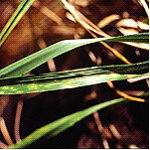 Festuca arundinacea
Festuca arundinacea 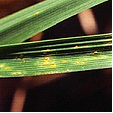 Rust
Rust
Turf Grass are susceptible to rust (Puccinia species) and (Uromyces species), causing yellow flecks to appear on the stems and leaves. These markings enlarge before the pustules form and in severs cases the lawn has a yellow, red or brown appearance.
The infection appears from spring to summer under humid low light conditions and turf that is under stress or with excessive nitrogen in the soil is more susceptible. Many species may be infected including Lolium perenne (Perennial Ryegrass) and Poa pratensis (Kentucky Bluegrass).

 Rust on Perennial Ryegrass
Rust on Perennial Ryegrass
Viburnum species are mildly affected by two types of rust (Coleosporium viburni) and (Puccinia linkii).
Viola species are infected by the rust (Puccinia violae) which forms green spots on the underside of the leaves. It is not commonly seen on cultivated plants.
Non-chemical Control
Cut off and destroy any infected branches, fallen leaves and remove heavily infected plants. Improve the culture by, pruning to improve air circulation, allow space between plants and avoid over crowding. Avoid planting susceptible species. Plants that are infected with a systemic form should be removed and destroyed
Chemical Control
Not possible to spray large trees but young plants may be treated with a protectant fungicide such as wettable sulphur. In a domestic garden small plants such as Fuchsia species may be sprayed with a protectant chemicals as symptoms appear, aided by the removal of existing infected leaves. Under commercial conditions stock may be sprayed with a fungicide such as oxycarboxin.
Note
Always read the label for registration details and direction of use prior to application of any chemicals.
Average Lowest Temperature : -3º C 27º F
USDA : 9, 10, 11
This USDA (United States Department of Agriculture) hardiness zone chart can be used to indicate a plant’s ability to withstand average minimum temperatures. However, other factors such as soil type, pH, and moisture, drainage, humidity and exposure to sun and wind will also have a direct effect on your plant’s survival. Use this chart only as a guide, always keep the other factors in mind when deciding where, when and what to plant.
A plant's individual USDA zone can be found in the Plant Overview.
Region of origin
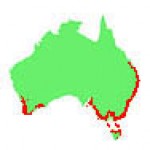
Australia (Queensland, New South Wales, Victoria, South Australia, Tasmania)
Climate Description
Warm Temperate
This zone has the majority of rain during winter in the west and summer in the east with high humidity. Summer temperatures may peak at 40ºC (104ºF).
Frost and drought mainly occur inland and coastal wind is normally accompanied with rain.
Plant growth
Wide range of native and exotic plants grow well.
| Dictionary | Growth Habit |
| Leaf Type | Botanic Flower Description |
| Leaf Shape | Flower Inflorescence |
| Leaf Arrangement | Fruit Type |
| Leaf Margin | Bark Type |
| Leaf Apex And Bases | Flower Description |